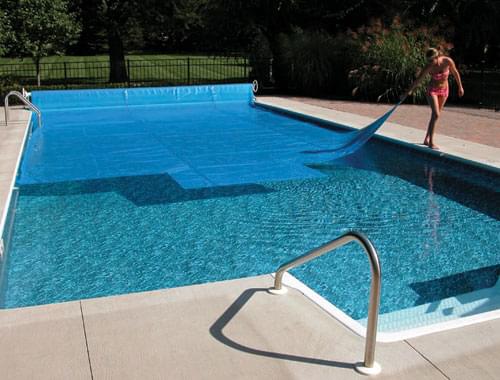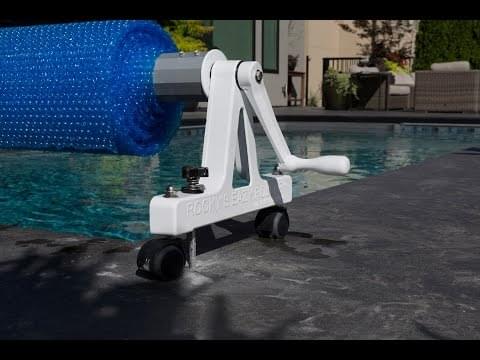Solar Cover Maintenance and Care
Solar covers are one of the most environmentally friendly, and efficient ways of warming your pool. Whether you use your solar cover as your primary warming method or in combination with a heater, it will save you money and extend the length of your pool season – but only if your solar cover is working properly. Basic maintenance will prevent your solar cover from getting ripped, delaminated, damaged, or dirty. Don’t waste your time and money replacing or repairing your pool cover. Instead keep it looking and working like it is brand new by following a few of these basic tips:

1) Protect the cover while swimming
When the cover is not on the pool you should protect it from the sunlight as much as possible. Although the solar covers are designed to be left on the cover during the day, the UV rays are strong enough to cause deterioration over time. All plastics are naturally susceptible to the deteriorating effects of UV rays.
To ensure your cover is protected, do your best to keep your solar cover out of direct sunlight in a shaded location. We highly recommend using a white opaque polyethylene protector which can be found in every solar cover category on our website.
Delamination due to improper exposure of the solar cover to direct sunlight (when off the pool) will result in voiding the warranty.
2) Handle with care
To prevent damage to the air cells (bubbles), the cover should be carefully lifted over abrasive pool decks, coping or sharp, ragged surface. Small rips can cause serious damage over time, and will reduce the efficiency of your solar cover.
3) High temperatures
Water temperatures above 90 degrees F may shorten the life of your solar pool cover. If pool temperatures rise above 90 degrees F the cover should be removed and covered with the white opaque polyethylene protector mentioned above. Using your solar cover in these temperatures can void the warranty.
When you are out of the pool, try to store your solar cover in a cool dark location, ideally below 100 degrees Fahrenheit.
4) Cleaning
Dirt and debris can block the sun’s rays reducing your solar cover’s heating ability. A clean cover allows for optimum solar heating.
Most dirt, debris and leaves can be hosed off the floating cover directly into your pool skimmer. Run the circulation pump while cleaning so as to send small debris into the skimmer and through the filter instead of into the pool. If necessary, the leaf basket or trap can be emptied after cleaning. Water and a soft brush are generally all that is required to remove heavier grime and algae from the cover.
The best way to clean your solar cover is to avoid getting it dirty in the first place. When storing your cover, avoid throwing it onto the grass or pool deck. Sand, grit, and organic materials will not only make your solar cover dirty, they will also end up falling into your pool, causing damage to your pool lining and causing algae growth.
5) Storage
After cleaning the solar cover, allow it to dry. Once dry, fold it into four-foot widths and roll it up from one end. It can now be stored standing on end, in its original shipping carton or in a large plastic bag. Always store it in a shaded or protected area below 120 degrees F. If you have a solar roller, you may roll up the cover and place the protective sheet overtop - preferably in the shade.
7) Winter season
Do NOT leave you cover on your pool after the swimming season ends. Your solar cover is not a winter cover and its life may be severely shortened by winter conditions. Specialty winter covers will better protect your pool, and won’t be damaged by fall and winter weather.
Before storing your solar cover, be sure to clean it thoroughly and set it out to dry, otherwise mildew and other bacteria will build up giving you a nasty surprise in the spring! When storing your solar cover, it should be placed in a dry, safe place. Winter damage will not be covered under the warranty, so you may want to invest in a winter solar blanket cover to protect the cover from debris, moisture, and dust.
8) Chemicals
Chlorine and other pool chemicals are the number one reason that solar covers degrade over time. Maintain chlorine at the proper level as recommended by your chemical company. When you "super chlorinate", the cover must be removed from the pool to avoid deterioration. Do not return your cover to the pool until chlorine levels are low and in the ideal range.

9) Invest in a solar cover reel
Many people choose to invest in a solar cover reel, which allows you to gently and evenly deploy or retract your pool cover, minimizing the risk of damage. The ideal solar cover reel should prevent your cover from sagging, for thicker covers you will want to invest in a reel with a larger tube diameter, which will keep the cover taut. A sagging solar cover will increase the risk or rips or tears.
10) Make small repairs
Make small repairs before they get big. Small tears can turn into big rips over time unless you repair them. Specialized solar cover repair kits are available, but you can also use adapt other repair kits in a pinch. Remember, the point of a solar pool cover is to allow light through in order to heat your pool, so try to avoid using opaque repair materials.
11) Time your pump and filters
Your solar cover magnifies the sunlight, causing the water underneath to warm. The warmer water rises to the top, and brings with it a higher concentration of chlorine. Timing your pumping and filtration system to the warmest part of the day (approximately 10am to 4pm) will circulate the hot and cool water around your pool. This should help spread the heat more evenly throughout the pool while preventing hot water and chlorine from building up at the top of the pool, which can damage your cover.





